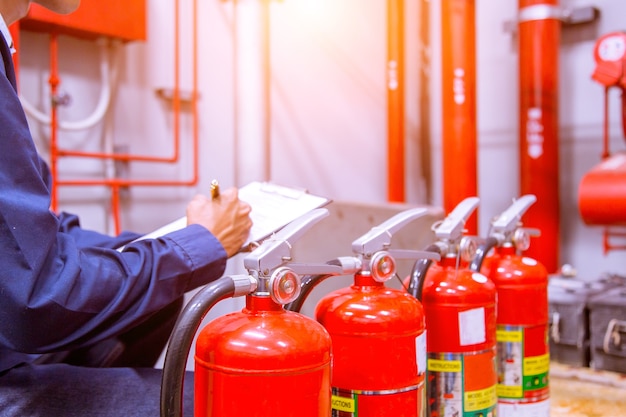Introduction
We will explore everything you need to know about fire extinguisher, from their importance in fire safety to their various types and usage. So, if you're looking to enhance your knowledge and become well-versed in fire safety, you're in the right place.

Fire Extinguisher: An Essential Safety Device
Fire safety is of utmost importance, whether at home, in the workplace, or any other setting. A fire extinguisher is a versatile and essential safety device designed to combat fires and prevent them from spreading. With its effectiveness in suppressing fires, the fire extinguisher has gained significant popularity and is considered a top trending safety product.
Understanding Fire and the Need for Extinguishers
Before diving into the specifics of fire extinguishers, it's essential to understand fire itself and the reasons why we need tools to extinguish it. Fire is a rapid chemical reaction that releases heat, light, and flames, often resulting in destruction and endangering lives. It requires three elements to sustain: heat, fuel, and oxygen. Fire extinguishers are designed to eliminate at least one of these elements, thus stopping the fire from spreading.
The Importance of Having a Fire Extinguisher
Having a fire extinguisher readily available is crucial for several reasons:
Early Fire Suppression: In the event of a small fire, having a fire extinguisher nearby allows for immediate action to suppress the fire before it grows out of control.
Protection of Life and Property: Fire extinguishers can help save lives and prevent property damage by containing fires in their early stages, giving people time to evacuate and minimizing the spread of flames.
Quick Response: Fire extinguishers provide a quick response to fire emergencies, allowing individuals to take action promptly and potentially prevent a disaster.
Fire Safety Compliance: Many jurisdictions and building codes require the presence of fire extinguishers in residential, commercial, and public buildings to ensure compliance with fire safety regulations.
Types of Fire Extinguishers
Fire extinguishers come in various types, each suitable for specific fire scenarios. Let's take a closer look at the different types of fire extinguishers and their applications.
Water and Foam Fire Extinguishers
Water and foam fire extinguishers are effective against Class A fires, which involve ordinary combustible materials such as wood, paper, fabric, and plastics. The water cools the fire, while foam creates a barrier that helps prevent re-ignition.
Carbon Dioxide (CO2) Fire Extinguishers
Carbon dioxide (CO2) fire extinguishers are primarily used for Class B and C fires. Class B fires involve flammable liquids like gasoline and oil, while Class C fires involve electrical equipment. CO2 extinguishers work by displacing oxygen and suffocating the fire.
Dry Chemical Powder Fire Extinguishers
Dry chemical powder fire extinguishers are versatile and can be used for different types of fires. They are effective against Class A, B, and C fires. The powder interrupts the chemical reaction of the fire and helps smother the flames.
Wet Chemical Fire Extinguishers
Wet chemical fire extinguishers are specifically designed for Class F fires, which involve cooking oils and fats. The wet chemical agent creates a cooling effect and forms a soap-like solution that prevents re-ignition.
Clean Agent Fire Extinguishers
Clean agent fire extinguishers are suitable for Class B and C fires. They use non-conductive and non-corrosive agents to suppress the fire, making them ideal for protecting sensitive electronic equipment.
FAQs (Frequently Asked Questions)
How often should fire extinguishers be inspected?
Fire extinguishers should be inspected and maintained regularly. It is recommended to have a professional inspection annually and perform visual checks monthly. Additionally, make sure to check the pressure gauge regularly to ensure it's within the recommended range.
Can I recharge a fire extinguisher after use?
Most fire extinguishers can be recharged after use. However, it is important to have them recharged by a professional service provider to ensure they are properly refilled and pressurized.
How long does a fire extinguisher last?
The lifespan of a fire extinguisher can vary depending on the type and manufacturer. However, most extinguishers have a lifespan of around 10-12 years. It is crucial to check the expiration date on the extinguisher and replace it when it reaches the end of its service life.
Are all fire extinguishers suitable for all fire scenarios?
While fire extinguishers are designed to combat specific types of fires, it's important to choose the appropriate type based on the fire hazard. Using the wrong type of extinguisher can be ineffective or even dangerous. Refer to the labels and instructions on the extinguisher to ensure you select the right one for the specific fire scenario.
Can fire extinguishers be used more than once?
Yes, fire extinguishers can be used multiple times until they are empty or need recharging. However, it is important to remember that once a fire extinguisher has been discharged partially, it should be recharged or replaced to ensure it is ready for future emergencies.
Conclusion
In conclusion, fire extinguishers are vital safety devices that play a crucial role in fire prevention and suppression. By understanding the different types of fire extinguishers and their applications, you can make informed choices when it comes to fire safety preparedness. Remember to have fire extinguishers inspected regularly, follow proper usage techniques, and prioritize fire safety in all environments.





